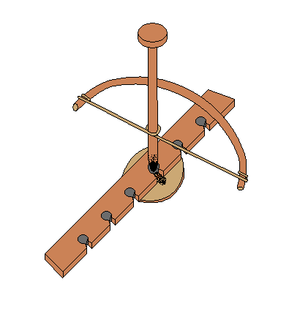(add info about socket.) |
(→Intro) |
||
| (One intermediate revision by the same user not shown) | |||
| Line 1: | Line 1: | ||
| + | [[Image:Bow Drill.png|thumb|300px]] | ||
:The "bow and drill" method is well-known (or well-fabled) and it is a lot of work. The bow is similar to that used for archery. To make such a bow, find a thin rope or flexible but sturdy vine, and a sturdy stick about two feet long. Tie the rope to one end of the stick, and make another knot on the other end of the stick, with the rope between the ends not quite taut. The drill is another straight stick, thin but strong, preferably stripped of bark, sharpened on the bottom end and rounded on the top. The center of the bowstring (rope) is wrapped around the drill, with the two sticks at right angles to each other. The end of the drill is placed on a piece of bark in the middle of the tinder. The top of the drill is placed in a socket made of a hardwood, bone, stone, or something similar. The socket should be greased to reduce friction - you do not want to generate heat in the socket. The bow is moved rapidly back and forth to rotate the drill and create heat and friction on the bark. This method works best with an assistant feeding the tinder to the hot spot. | :The "bow and drill" method is well-known (or well-fabled) and it is a lot of work. The bow is similar to that used for archery. To make such a bow, find a thin rope or flexible but sturdy vine, and a sturdy stick about two feet long. Tie the rope to one end of the stick, and make another knot on the other end of the stick, with the rope between the ends not quite taut. The drill is another straight stick, thin but strong, preferably stripped of bark, sharpened on the bottom end and rounded on the top. The center of the bowstring (rope) is wrapped around the drill, with the two sticks at right angles to each other. The end of the drill is placed on a piece of bark in the middle of the tinder. The top of the drill is placed in a socket made of a hardwood, bone, stone, or something similar. The socket should be greased to reduce friction - you do not want to generate heat in the socket. The bow is moved rapidly back and forth to rotate the drill and create heat and friction on the bark. This method works best with an assistant feeding the tinder to the hot spot. | ||
| Line 4: | Line 5: | ||
:* [http://homepage.mac.com/laddie/fire_by_friction.html Fire by Friction] | :* [http://homepage.mac.com/laddie/fire_by_friction.html Fire by Friction] | ||
:* [http://en.wikipedia.org/wiki/Fire_stick#Friction Making fire with friction] | :* [http://en.wikipedia.org/wiki/Fire_stick#Friction Making fire with friction] | ||
| + | {{clear}} | ||
| + | [[Category:Adventist Youth Honors Answer Book|{{SUBPAGENAME}}]] | ||
Revision as of 13:54, 9 April 2008
- The "bow and drill" method is well-known (or well-fabled) and it is a lot of work. The bow is similar to that used for archery. To make such a bow, find a thin rope or flexible but sturdy vine, and a sturdy stick about two feet long. Tie the rope to one end of the stick, and make another knot on the other end of the stick, with the rope between the ends not quite taut. The drill is another straight stick, thin but strong, preferably stripped of bark, sharpened on the bottom end and rounded on the top. The center of the bowstring (rope) is wrapped around the drill, with the two sticks at right angles to each other. The end of the drill is placed on a piece of bark in the middle of the tinder. The top of the drill is placed in a socket made of a hardwood, bone, stone, or something similar. The socket should be greased to reduce friction - you do not want to generate heat in the socket. The bow is moved rapidly back and forth to rotate the drill and create heat and friction on the bark. This method works best with an assistant feeding the tinder to the hot spot.

